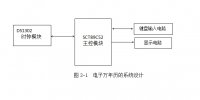基于C语言RTC的万年历的设计

基于C语言RTC的万年历的设计(任务书,开题报告,论文11700字)
摘要
随着科技的不断发展,现代化的电子时钟逐渐走进人们的生活。本次毕业设计就是设计一个基于单片机的电子万年历,本设计的主控制器就是选用STC89C52单片机。单片机可以说是一个有着多种功能的微型处理器,它具有轻便简洁,成本低廉,功能强大等特点。52系列的单片机现在发展的更为成熟,也是大家比较熟悉和使用较多的芯片。这次毕业设计就是通过对它的学习理解来进行应用从而增强自己软件和硬件开发的能力。
本文就是采用单片机为核心完成多功能电子万年历的设计,学习单片机指令和应用的知识。本次设计主要的控制器是STC89C52,时钟芯片为DS1302,LCD显示屏,来实现显示实时时间日期,并且具有农历查询,平年闰年的判断等多种功能。
关键词:单片机农历查询万年历
Design of Calendar Based on C Language RTC
Abstract
With the continuous development of science and technology, modern electronic clock gradually into people's lives. The graduation design is the design of a single-chip electronic calendar, the design of the main controller is the choice of STC89C52 Singlechip. SCM can be said to have a variety of functions of the micro-processor, it has a light and simple, low cost, powerful features. 52 series of Singlechip now develop more mature, but also we are more familiar with and use more chips. This graduation design is through its understanding of learning to be applied to enhance their own software and hardware development capabilities.This article is the use of single-chip as the core to complete the design of multifunctionelectronic calendar, learning Singlechip and application of knowledge. The main controller of this design is STC89C52, the clock chip for the DS1302, LCD display, to achieve real-time display date and date, and has a lunar calendar, the first year leap year to judge a variety of functions. [资料来源:http://doc163.com]
Keywords:Singlechip;The lunar query;Calendar
[来源:http://Doc163.com]

目录
摘要 4
Abstract 5
第一章 绪论 6
1.1 选题的依据及意义 6
1.2 国内外研究现状及发展趋势 7
1.3 本课题研究内容 7
1.4 论文的结构安排 8
第二章 设计方案及论证 9
2.1 设计要求 9
2.2 系统基本方案选择和论证 9
2.2.1主控制芯片的选择方案和论证 9
2.2.2 显示模块选择方案和论证 9
2.2.3时钟芯片的选择方案和论证 10
2.3 电路设计最终方案确定 11
第三章 系统的硬件设计与实现 12
3.1电子万年历的系统设计 12 [来源:http://www.doc163.com]
3.2 单片机最小系统设计 12
3.2.1时钟电路 13
3.2.2复位电路 14
3.3 DS1302时钟芯片介绍 14
3.3.1 DS1302控制字的介绍 14
3.2.4 DS1302单字节读写时序介绍 16
3.2.5 DS1302操作指令介绍 17
3.4 显示电路 17
3.4 按键电路 19
3.4.1 键盘接口介绍 19
3.4.2按键电路设计 20
第四章 软件设计 21
4.1主程序流程图 21
4.2时间调整程序设计 22
4.3阳历显示程序的设计 22
4.4 阴历程序设计 23
第五章 系统调试与仿真 27
5.1软件调试 27
5.2仿真 27
5.3 硬件调试 28
5.4测试结论 31
第六章 总结 32
致谢 33
参考文献 34
[资料来源:www.doc163.com]
